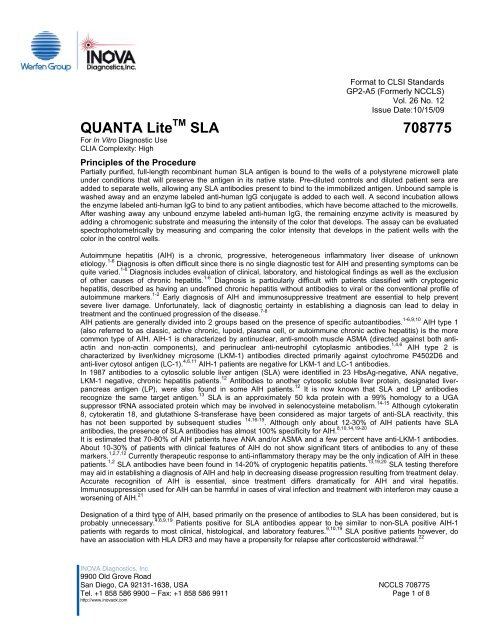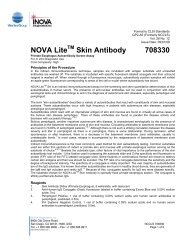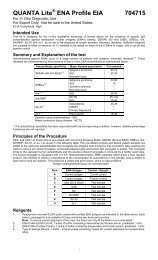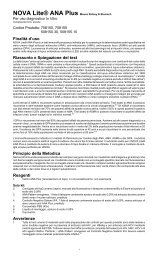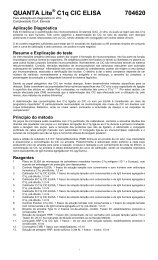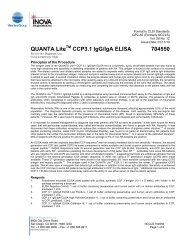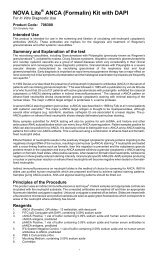QUANTA Lite SLA 708775 - inova
QUANTA Lite SLA 708775 - inova
QUANTA Lite SLA 708775 - inova
You also want an ePaper? Increase the reach of your titles
YUMPU automatically turns print PDFs into web optimized ePapers that Google loves.
3. Additional controls may be tested according to guidelines or requirements of local, state and/or federalregulations or accrediting organizations. Additional suitable control sera may be prepared by aliquotingpooled human serum specimens and storing at < -20°C.4. In order for the test results to be considered valid, all of the criteria listed below must be met. If any of theseare not met, the test should be considered invalid and the assay repeated.a. The absorbance of the prediluted <strong>SLA</strong> ELISA High Positive must be greater than the absorbance ofthe prediluted <strong>SLA</strong> ELISA Low Positive, which must be greater than the absorbance of theprediluted ELISA Negative Control.b. The prediluted <strong>SLA</strong> ELISA High Positive must have an absorbance greater than 1.0 while theprediluted ELISA Negative Control absorbance cannot be over 0.2.c. The <strong>SLA</strong> ELISA Low Positive absorbance must be more than twice the ELISA Negative Control orover 0.25.d. The ELISA Negative Control and <strong>SLA</strong> ELISA High Positive are intended to monitor for substantialreagent failure. The <strong>SLA</strong> ELISA High Positive will not ensure precision at the assay cutoff.e. The user should refer to NCCLS Document C24-A for additional guidance on appropriate QCpractices. 24Method:Before you start1. Bring all reagents and samples to room temperature (20-26 o C) and mix well.2. Dilute the HRP Wash Concentrate 1:40 by adding the contents of the HRP Wash Concentrate bottle to975mL of distilled or deionized water. If the entire plate will not be run within this period, a smaller quantitycan be prepared by adding 2.0mL of the concentrate to 78mL of distilled or deionized water for every 16wells that will be used. The diluted buffer is stable for 1 week at 2-8 o C.3. Prepare a 1:101 dilution of each patient sample by adding 5µL of sample to 500µL of HRP Sample Diluent.Diluted samples must be used within 8 hours of preparation. DO NOT DILUTE the <strong>SLA</strong> ELISA Low Positive,<strong>SLA</strong> ELISA High Positive and ELISA Negative Control.4. Determination of the presence or absence of <strong>SLA</strong> using arbitrary units requires two wells for each of thethree controls and one or two wells for each patient sample. It is recommended that samples be run induplicate.Assay ProcedurePlace the required number of microwells/strips in the holder. Immediately return unused strips to the pouchcontaining desiccants and seal securely to minimize exposure to water vapor.2. Add 100µL of the prediluted <strong>SLA</strong> ELISA Low Positive, the <strong>SLA</strong> ELISA High Positive, the ELISA NegativeControl and the diluted patient samples to the wells. Cover the wells and incubate for 30 minutes at roomtemperature on a level surface. The incubation time begins after the last sample addition.3. Wash step: Thoroughly aspirate the contents of each well. Add 200-300µL of the diluted HRP Wash bufferto all wells then aspirate. Repeat this sequence twice more for a total of three washes. Invert the plate andtap it on absorbent material to remove any residual fluid after the last wash. It is important to completelyempty each well after each washing step. Maintain the same sequence for the aspiration as was used forthe sample addition.4. Add 100μL of the HRP IgG Conjugate to each well. Conjugate should be removed from the bottles usingstandard aseptic conditions and good laboratory techniques. Remove only the amount of conjugate from thebottle necessary for the assay. TO AVOID POTENTIAL MICROBIAL AND/OR CHEMICALCONTAMINATION, NEVER RETURN UNUSED CONJUGATE TO THE BOTTLE. Incubate the wells for 30minutes as in step 2.5. Wash step: Repeat step 3.6. Add 100µL of TMB Chromogen to each well and incubate in the dark for 30 minutes at room temperature.7. Add 100µL of HRP Stop Solution to each well. Maintain the same sequence and timing of HRP StopSolution addition as was used for the TMB Chromogen. Gently tap the plate with a finger to thoroughly mixthe wells.8. Read the absorbance (OD) of each well at 450nm within one hour of stopping the reaction. If bichromaticmeasurements are desired, 620nm can be used as a reference wavelength.Reporting Results:Interpretation of ResultsThe ELISA assay is very sensitive to technique and is capable of detecting even small differences in patientpopulations. The values shown below are suggested values only. Each laboratory should establish its own normalrange based upon its own techniques, controls, equipment and patient population according to their own establishedprocedures.NCCLS <strong>708775</strong>Page 4 of 8
Samples are interpreted as negative (negative for IgG antibody to <strong>SLA</strong>), equivocal, or positive (IgG antibody to <strong>SLA</strong>detected) according to the table below:NegativeEquivocalPositive0.0 - 20.0 Units20.1 - 24.9 Units≥ 25 UnitsEquivocal specimens should be re-tested before results are reported.1. A positive result indicates the presence of IgG antibodies to <strong>SLA</strong> and suggests the possibility of autoimmunehepatitis.2. A specimen with equivocal levels of <strong>SLA</strong> IgG cannot be assessed for antibody status. If the results remainequivocal after repeat testing, the result should be reported as equivocal and/or an additional sample shouldbe taken.3. A negative result indicates no IgG antibody to <strong>SLA</strong> or levels below the detection limit of the assay.4. Specimens giving OD readings above the readable range of the plate reader may be reported as greaterthan the highest measurable OD divided by the Low positive OD times 25 or they may be diluted, re-run,and a calculated value obtained. The approximate linear range of the assay extends from 9 to 125 units.5. It is suggested that the results reported by the laboratory should include: “The following results wereobtained with the INOVA <strong>QUANTA</strong> <strong>Lite</strong> TM <strong>SLA</strong> ELISA. <strong>SLA</strong> values obtained with different manufacturers’assay methods may not be used interchangeably. The magnitude of the reported IgG levels cannot becorrelated to an endpoint titer.”CalculationsCalculation of ResultsThe average OD for each set of duplicates is first determined. The reactivity for each sample can then be calculatedby dividing the average OD of the sample by the average OD of the <strong>SLA</strong> ELISA Low Positive. The result is multipliedby the number of units assigned to the <strong>SLA</strong> ELISA Low Positive found on the label.Sample ODSample Value = ———————————————————— x <strong>SLA</strong> ELISA Low Positive(units) <strong>SLA</strong> ELISA Low Positive OD (units)Reactivity is related to the quantity of antibody present in a non-linear fashion. While increases and decreases inpatient antibody concentrations will be reflected in a corresponding rise or fall in reactivity, the change is notproportional (i.e. a doubling of the antibody concentration will not double the reactivity). If a more accuratequantitation of patient antibody is required, serial dilutions of the patient sample should be run and the last dilution tomeasure positive in the assay should be reported as the patient's antibody titer.Expected ValuesThe mean annual incidence of AIH was estimated to be 1.9 cases /100,000 in Western Europe and North AmericanCaucasian populations and 0.08-0.015 cases/100,000 in Japan. 25,27 The prevalence was estimated to be16.9/100,000 in a Norwegian population. 26 The disease is most prevalent in females with a female to male ratio of4:1. Peak incidence occurs between the ages of 15-30, although it occurs in all age groups. 1-5Normal RangeA panel of 131 asymptomatic, healthy individuals was tested for <strong>SLA</strong> antibodies with the <strong>QUANTA</strong> <strong>Lite</strong> TM <strong>SLA</strong> ELISA.The panel consisted of 91 male and 40 female individuals. No difference between the average values of males andfemales was detected. The ages ranged from 5-69 (median 33). The specificity of the assay was 100% (131/131) forthe panel tested. The average value for this population was 2.0 units with the highest value at 5.8 units.Specific Performance CharacteristicsAIH and Liver Disease PatientsSpecimens from patients with AIH and other liver diseases were tested blind in-house and at external sites using the<strong>QUANTA</strong> <strong>Lite</strong> TM <strong>SLA</strong> ELISA. Ages of the patients ranged from 13 to 82 with a male:female ratio of approximately 3.5.The results obtained from the various panels were combined and are summarized below.NCCLS <strong>708775</strong>Page 5 of 8
Clinical Group n= <strong>SLA</strong>+ % <strong>SLA</strong>+AIH-1 289 34 11.8AIH-1/PBC(primary biliary cirrhosis) overlap 20 11 55AIH-2 3 0 0Cryptogenic Hepatitis 9 4 44.4Autoimmune cholangitis 8 1 12.5AIH-1/PSC 4 1 25Drug-induced AIH 2 0 0Primary biliary cirrhosis 15 0 0Primary Sclerosing Cholangitis (PSC) 7 0 0PBC/PSC 19 0 0Other non-viral liver diseases 10 0 0Hepatitis B virus(B,C,or D) 8 0 0Hepatitis C virus 37 0 0Hepatitis C/D 1 0 0Sensitivity for AIH-1 exclusively: 34/289 = 11.8%Sensitivity for AIH-1 and AIH-1 variants (overlaps): 51/330 = 15.4%Specificity (non AIH liver disease): 73/73 = 100%Specificity (normal healthy plus non-AIH liver disease): 204/204 = 100%Cross-Reactivity StudySera from 70 patients with various autoimmune or infectious disease antibodies were tested for cross-reactivity withthe <strong>QUANTA</strong> <strong>Lite</strong> TM <strong>SLA</strong> ELISA . The groups of sera tested and the numbers of each were Human Herpes virus 6(10), Rickettsia (6), Cytomegalovirus (10), Glomerular basement membrane (3), Anti-nuclear antibody (3), systemiclupus erythematosus (3), mitochondria (3), gastric parietal cell (3), LKM-1 (3), cytokeratin 8 or 18 (26). No samplewas interpreted as positive for <strong>SLA</strong> antibodies.Precision and ReproducibilityIntra-assay Performance for <strong>QUANTA</strong> <strong>Lite</strong> TM <strong>SLA</strong> ELISA was evaluated by testing 6 specimens a total of 7 timeseach. The results are summarized below.Intra-assay Performance of <strong>QUANTA</strong> <strong>Lite</strong> TM <strong>SLA</strong> ELISASpec. A Spec. B Spec. C Spec. D Spec. E Spec. FMean Units 72.6 46.2 27.6 13.5 9.7 2.0SD 1.4 1.9 1.4 0.4 0.2 0.1CV% 1.9 4.1 5.2 2.8 2.2 7.2Inter-assay variation was assessed by testing, in duplicate, a panel of 5 specimens and the kit controls twice daily for3 days. A summary of the results is shown below.Inter-assay Performance for <strong>QUANTA</strong> <strong>Lite</strong> TM <strong>SLA</strong> ELISASpec. A Spec. B Spec. C Spec. D Spec. EMean Units 78.5 48.5 29.0 13.6 9.5SD 1.8 1.1 0.9 0.5 0.4CV% 1.9 4.1 5.2 2.8 2.2Limitations of the Procedure1. A negative <strong>SLA</strong> result does not rule out the presence of autoimmune hepatitis.2. A negative <strong>SLA</strong> antibody result does not rule out the presence of <strong>SLA</strong> antibodies, because the concentrationof antibody may be below the detection limit of the assay.3. A positive test result only indicates the presence of antibody to human recombinant <strong>SLA</strong> and does notnecessarily indicate the presence of autoimmune hepatitis.4. Diagnosis of autoimmune hepatitis requires the cumulative documentation of a patient’s demographics,clinical presentation, and other diagnostic testing.5. The literature suggests that anti-<strong>SLA</strong> antibodies are not characteristic of AIH-2. 10 Although the three AIH-2specimens shown in the Specific Performance section below were negative, this number is not large enoughto validate the lack of <strong>SLA</strong> antibodies in AIH-2 specimens by the present assay.6. Results of this assay should be used in conjunction with clinical findings and other serological tests.7. The assay performance characteristics have not been established for matrices other than serum.NCCLS <strong>708775</strong>Page 6 of 8
References1. Krawitt EL. Autoimmune hepatitis. N Engl J Med. 1996;334(14):897-903.2. Krawitt EL. Can you recognize autoimmune hepatitis? Postgrad Med. 1998;104(2):145-149, 152.3. Alvarez F, Berg PA, Bianchi FB, et al. International Autoimmune Hepatitis Group Report: review of criteriafor diagnosis of autoimmune hepatitis. J Hepatol. 1999;31(5):929-938.4. Obermayer-Straub P, Strassburg CP, Manns MP. Autoimmune hepatitis. J Hepatol. 2000;32(1 Suppl):181-197.5. Manns MP, Strassburg CP. Autoimmune hepatitis: clinical challenges. Gastroenterology. 2001;120(6):1502-1517.6. Czaja AJ, Homburger HA. Autoantibodies in liver disease. Gastroenterology. 2001;120(1):239-249.7. Meyer zum Buschenfelde KH, Lohse AW. Autoimmune hepatitis. N Engl J Med. 1995 Oct 12;333(15):1004-1005.8. Kanzler S, Weidemann C, Gerken G, Lohr HF, Galle PR, Meyer zum Buschenfelde KH, Lohse AW. Clinicalsignificance of autoantibodies to soluble liver antigen in autoimmune hepatitis. J Hepatol. 1999;31(4):635-640.9. McFarlane IG. The relationship between autoimmune markers and different clinical syndromes inautoimmune hepatitis. Gut. 1998;42:599-602.10. Ballot E, Homberg JC, Johanet C. Antibodies to soluble liver antigen: an additional marker in type 1 autoimmunehepatitis. J Hepatol. 2000;33(2):208-215.11. Lapierre P, Hajoui O, Homberg JC, Alvarez F. Formiminotransferase cyclodeaminase is an organ-specificautoantigen recognized by sera of patients with autoimmune hepatitis. Gastroenterology. 1999Mar;116(3):643-649.12. Manns M, Gerken G, Kyriatsoulis A, Staritz M, Meyer zum Buschenfelde KH. Characterization of a newsubgroup of autoimmune chronic active hepatitis by autoantibodies against a soluble liver antigen. Lancet.1987;1:292-294.13. Stechemesser E, Klein R, Berg PA. Characterization and clinical relevance of liver-pancreas antibodies inautoimmune hepatitis. Hepatology. 1993;18(1):1-9.14. Wies I, Brunner S, Henninger J, Herkel J, Kanzler S, Meyer zum Buschenfelde KH, Lohse AW. Identificationof target antigen for <strong>SLA</strong>/LP autoantibodies in autoimmune hepatitis. Lancet. 2000 29;355(9214):1510-1515.15. Costa M, Rodriguez-Sanchez JL, Czaja AJ, Gelpi C. Isolation and characterization of cDNA encoding theantigenic protein of the human tRNP(Ser)Sec complex recognized by autoantibodies from patients withtype-1 autoimmune hepatitis. Clin Exp Immunol. 2000;121(2):364-374.16. Wachter B, Kyriatsoulis A, Lohse AW, Gerken G, Meyer zum Buschenfelde KH, Manns MP.Characterization of liver cytokeratin as a major target antigen of anti-<strong>SLA</strong> antibodies. J Hepatol.1990;11(2):232-239.17. Wesierska-Gadek J, Grimm R, Hitchman E, Penner E. Members of the glutathione S-transferase genefamily are antigens in autoimmune hepatitis. Gastroenterology. 1998 Feb;114(2):329-335.18. Klein R, Berg PA. Glutathione S-transferase as a major autoantigen in anti-<strong>SLA</strong>-positive autoimmunehepatitis. Gastroenterology. 1998;116(4):1015-1016.19. Manns MP. Antibodies to soluble liver antigen: specific marker of autoimmune hepatitis. J Hepatol.2000;33(2):326-328.20. Czaja AJ, Carpenter HA, Manns MP. Antibodies to soluble liver antigen, P450IID6, and mitochondrialcomplexes in chronic hepatitis. Gastroenterology. 1993;105(5):1522-1528.21. Dalekos GN, Wedemeyer H, Obermayer-Straub P, Kayser A, Barut A, Frank H, Manns MP. Epitopemapping of cytochrome P4502D6 autoantigen in patients with chronic hepatitis C during alpha-interferontreatment. J. Hepatol. 1999;30(3):366-375.22. Czaja AJ, Donaldson PT, Lohse AW. Antibodies to soluble liver antigen/liver pancreas and HLA risk factorsfor type 1 autoimmune hepatitis. Am J Gastroenterol. 2002;97:413-419.23. Biosafety in Microbiological and Biomedical Laboratories. Center for Disease Control/National Institute ofHealth, 1999, Fourth Edition, (HHS Pub. # (CDC) 93-8395).24. National Committee for Clinical Laboratory Standards. 1991. Internal quality control: Principles anddefinitions; Approved Guideline, NCCLS Document C24-A, Vol.11(6).25. Nishioka M, Morshed SA, Parveen S, Kono K, Matsuoka H, Manns MP. Antibodies to P450IID6, <strong>SLA</strong>, PDH-E2 and BCKD-E2 in Japanese patients with chronic hepatitis. J Gastroenterol Hepatol. 1997;12(12):862-868.NCCLS <strong>708775</strong>Page 7 of 8
26. Boberg KM, Aadland E, Jahnsen J, Raknerud N, Stiris M, Bell H. Incidence and prevalence of primary biliarycirrhosis, primary sclerosing cholangitis, and autoimmune hepatitis in a Norwegian population. Scand JGastroenterol. 1998;33(1):99-103.27. Jacobson DL, Gange SJ, Rose NR, Graham NM. Epidemiology and estimated population burden ofselected autoimmune diseases in the United States. Clin Immunol Immunopathol. 1997; 84(3):223-243.INOVA Diagnostics, Inc. 858-586-99009900 Old Grove Road 628775 Rev. 3San Diego, CA 921312005/JUNNCCLS <strong>708775</strong>Page 8 of 8


